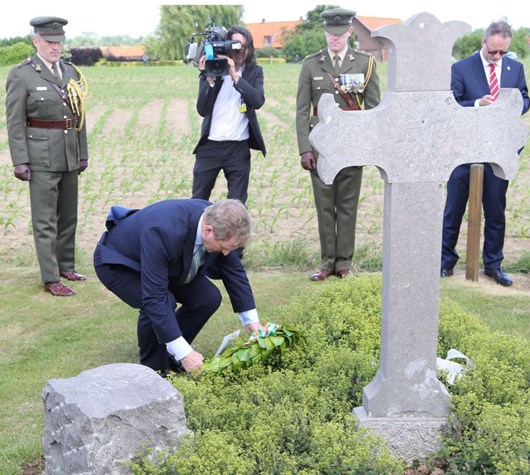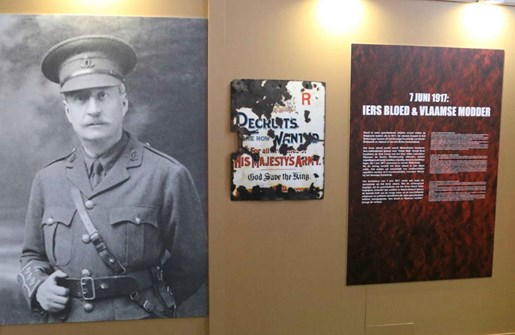Willie Redmond and the Commemoration of the Centenary of the Battle of Messines
- Home
- Latest News
- 2018
- January 2018
- Willie Redmond and the Commemoration of the Centenary of the Battle of Messines
June 7th 2017 was the centenary of the Battle of Messines, a battle in which the Catholic and Nationalist 16th(Irish) Division fought side by side with the Protestant and Unionist 36th (Ulster) Division. In view of this Irish involvement, a joint Ireland – United Kingdom commemoration was held at the Irish Peace Park in Messines.
As the great-grand-nephew and great-grand-niece of the Irish MP Major Willie Redmond who was fatally wounded at the start of the battle, myself and my sister Mary Green were invited to attend the commemorations as guests of the Irish Department of Foreign Affairs.
Commemoration at Willie Redmond’s grave
After the Home Rule Bill giving Ireland a degree of self-government had been given Royal assent in September 1914, Willie’s brother John Redmond, the leader of the Irish Parliamentary Party in the House of Commons, gave a speech at Woodenbridge County Wicklow. He called upon Irishmen to “account for themselves … wherever the firing line extends”. Following his brother’s call, Willie Redmond volunteered to join the 6th Royal Irish Regiment and he took part in the opening attack of the Battle of Messines.
He was hit twice by shrapnel soon after he left the 6th Royal Irish Regiment trench opposite the mine crater at Maedelstede Farm. He was found by Private John Meeke of the 11th Inniskillings, part of the 36th (Ulster) Division, who attempted to attend to his wounds. Private Meeke was wounded himself but remained with Major Redmond until further soldiers from the 36th arrived. Redmond was taken to the Main Dressing Station of the 108th Field Ambulance at Dranoutre where he died the same evening. Redmond’s body was taken to the Catholic Convent at Locre and he was buried in the convent grounds the next day. John Meeke recovered from his wounds and was awarded the Military medal for his gallantry.
After the war the Imperial War Graves Commission wanted to move Redmond’s body to a war graves cemetery but his widow Eleanor refused permission, stating that she wanted it “left where it is in the good care of the nuns”. Most unusually her wish prevailed and Redmond’s grave is in the same spot where he was buried in 1917. In the 1960s the Redmond family gave permission for the CWGC to move his body as the grave had by then fallen into disrepair. However, there was considerable local opposition and no move took place. In the 1990s the CWGC formally took over maintenance of the grave.
Willie Redmond was the most prominent Irish casualty of the battle and the Irish Government decided to hold a ceremony at his grave on the morning of 7th June 2017 – the centenary of his death.
The ceremony was attended by the Irish Taoiseach Enda Kenny, three Irish Government Ministers and representatives of the Irish Defence Forces. The Irish delegation laid wreaths and wrote messages in the visitors’ book.

Enda Kenny lays a wreath at Willie Redmond’s grave at Loker
Main commemoration at the Peace Park
The main Irish-United Kingdom Commemoration of the Battle of Messines Ridge took place at the Island of Ireland Peace Park on the afternoon of June 7th. Taoiseach Enda Kenny represented the Republic of Ireland, HRH the Duke of Cambridge represented the United Kingdom and HRH Princess Astrid represented Belgium.
Highlights of the ceremony included reading from Sir Philip Gibbs’ book “Bapaume to Passchendaele”, a reading of Francis Ledwidge’s poem “After My Last Song” and readings related to the death of Lt. Michael Wall, 6th Royal Irish Regiment who was killed during the battle.
After the wreath laying ceremony, the Remembrance Exhortation and The Last Post, extracts were read from the memoirs of Rev John Redmond who was the Anglican chaplain at the 36th Division’s 108th Field Ambulance dressing station in Dranoutre where Willie Redmond died. Rev. Redmond, no relation to Willie, had written to Willie’s widow Eleanor after Willie’s death and a copy of her letter in reply was reproduced in the commemorative booklet.
Commemorations at Wytschaete
A second ceremony was held in the nearby village of Wytschaete which was one of the objectives for the Irish Divisions on 7th June 1917.
The local council in Heuvelland commissioned a new memorial in the form of a silhouette depicting John Meeke carrying Willie Redmond off the battlefield. The silhouette has been installed near the existing Celtic Cross just outside the CWGC cemetery in Wytschaete. Nearby are Divisional stones for the 16th and 36th Divisions commemorating their part in the Battle of Messines. A bronze plaque telling the story of Willie Redmond and John Meeke has been installed in front of the silhouette. The road on which these memorials stand marks the divisional boundary between the 16th and 36th divisions on the 7th June 1917 .
The bronze plaque was unveiled by members of the Redmond and Meeke families in the presence of Taoiseach Enda Kenny, HRH the Duke of Cambridge and HRH Princess Astrid. Mary Green gave a brief account of the Redmond and Meeke story.
The picture below was taken before the unveiling. It shows relatives of John Meeke and relatives of Willie Redmond together with Alderman Etienne Cloet from Heuvelland who was a great supporter of the new memorials, and Erwin Ureel who was the driving force behind their design and construction.

Before the unveiling of the plague to Willie Redmond and John Meeke at Wytschaete
There are many incorrect stories about Willie Redmond’s death and burial and the wording on the plaque has been written to explain what actually happened. It reads as follows:
Near this spot on the morning of 7th June 1917, Major Willie Redmond MP, 6th Royal Irish Regiment, 16th (Irish) Division, was wounded during the opening attack of the Battle of Messines. He was found by Private John Meeke, 11th Royal Inniskilling Fusiliers, 36th (Ulster Division), who tried to carry him to safety until he was wounded himself. Meeke remained with him until further soldiers from the 36th Division arrived. Redmond was evacuated to the Dressing Station at Dranouter where he died of his wounds. He was 56. His body was taken to the convent chapel in Loker and he was buried in the convent grounds. His grave remains in the same place to this day. John Meeke was awarded the Military Medal for his gallant action. Willie Redmond had joined-up following the passage of the Home Rule Bill in the House of Commons and the call for volunteers by his brother John Redmond MP, the leader of the Irish Parliamentary Party. He urged others to do the same with the words “Don’t go, but come with me.”

The silhouette of Meeke and Redmond and the plaque
The ceremony then moved on to a wreath-laying ceremony at the Celtic Cross commemorating the 16th (Irish) Division. In the CWGC cemetery the VIPs witnessed the Field of Flanders soil ceremony, where Belgian children exchanged soil with children from Ireland and Northern Ireland to promote peace.
‘Irish Blood and Flemish Mud’ Exhibition in Kemmel
After the ceremony at Wytschaete the Irish delegation travelled to Kemmel and the Minister of Foreign Affairs Charles Flanaghan opened the exhibition ‘Irish Blood and Flemish Mud’.
The exhibition explained the political background to the formation of the 16th(Irish) and the 36th(Ulster) Divisions and their part in the Great War. It covered the 1916 rising and the post-war events leading to the formation of the Republic. The final part covered events up to the Good Friday agreement in 1998.
Willie Redmond featured prominently in several photographs, a reproduction bust and a film of him leading troops.

Photo of Willie Redmond at the entrance to the exhibition
John Green (Secretary Surrey Branch)





